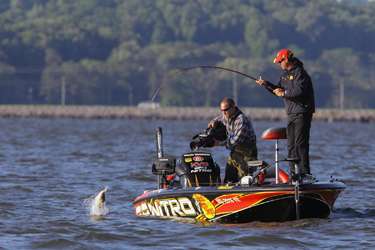
Versatility can be a virtue for tournament competitors … if they use the proper tools of the trade. However, the advantage they have in being versatile diminishes when they limit their rod choices for the wide array of tactics the Elite Series pros try on the tournament trail.
Even though he excels with just about any rod he picks up, Kevin VanDam relies on certain rod lengths and actions whenever he applies a particular technique. “I carry a lot of rods, but I have certain models that I use for multiple things.
There are also some that are extremely specific, especially cranking rods,” says the three-time Bassmaster Classic winner. “You have to have some for tight quarters and accuracy and throwing smaller baits, so you need softer action rods compared to an open-water rod for cranking ledges on Kentucky Lake.” While rod manufacturers continue to offer a variety of rods for special tactics, some models can handle multiple tasks.
VanDam’s choice for a multipurpose rod is one of his Quantum Tour KVD 6-foot, 10-inch high-modulus spinnerbait rods that allows VanDam to make accurate pitches in tight places, but has enough length to cast long distances with topwaters and jerkbaits. “When I’m getting ready for a tournament, a lot of times I’ll have 25 or 30 rods ready to go, but eight of those will be spinnerbait rods with different size lines to do a variety of different things, from swimming a jig to throwing a spinnerbait or jerkbait,” says VanDam, who also uses this rod for topwaters and skipping lures under docks.
“That rod with a 6.3:1 gear ratio reel on it can do a lot of things.” Other high-modulus graphite rods VanDam selects for specialized techniques are models in lengths of 6-6 and 7-2. Both models have an extra fast tip but plenty of backbone for power lures.
The Michigan pro uses a 6-6 medium-heavy action rod for throwing 1/4- or 3/8-ounce spinnerbaits in tight places or around targets such as thick bushes, laydowns and boat docks.
He prefers the 7-2 medium-heavy rod for burning 3/4-ounce spinnerbaits for smallmouth on Northern waters, fishing ledges with 3/4- or 1-ounce spinnerbaits, dragging football jigs or Carolina rigs and working small to mid-size swimbaits.
For all of his cranking tactics, VanDam favors rods constructed with a combination of E-glass and graphite. He likes the composite makeup of these rods because it delivers both the sensitivity of graphite and the limberness of glass. “So when you’re throwing a Redeye Shad (lipless crankbait) in grass you can feel when you have a little piece of grass on your bait or you can feel that crankbait when you’re hitting a mud bottom,” says VanDam.
“Then you also have the slower action of glass for when you are cranking into stumps and ledges and you want that rod to unload, and you have the softer action for fighting and playing fish with treble hooks when they are close to the boat.” VanDam chooses a 6 1/2-foot cranking model with medium action for tossing small topwaters and crankbaits around boat docks and other tight spots.
He moves up to a 6-8 model with a little stiffer action for casting larger crankbaits. The most versatile crankbait rods in VanDam’s rod box are 7-foot medium and 7-foot medium-heavy models. He favors the 7-foot medium for cranking small to medium diving plugs and relies on the medium-heavy action for running lipless crankbaits through grass.
Two other cranking rods VanDam chooses are a 7-4 version for mid-size crankbaits, such as the Strike King Series 5, and a 7-10 model for cranking large deep divers along ledges in the summertime. “If a guy was going to buy one crankbait rod, I would tell him to get a 7-foot medium or medium-heavy,” he advises.
“A few years ago, that was what I was throwing for everything from big to little plugs. Now that I have all these other actions, I can get more specialized.”
Editor’s Note: If you have a story idea you would like to vote on for an upcoming poll, send your idea to john@jnoutdoors.com.





